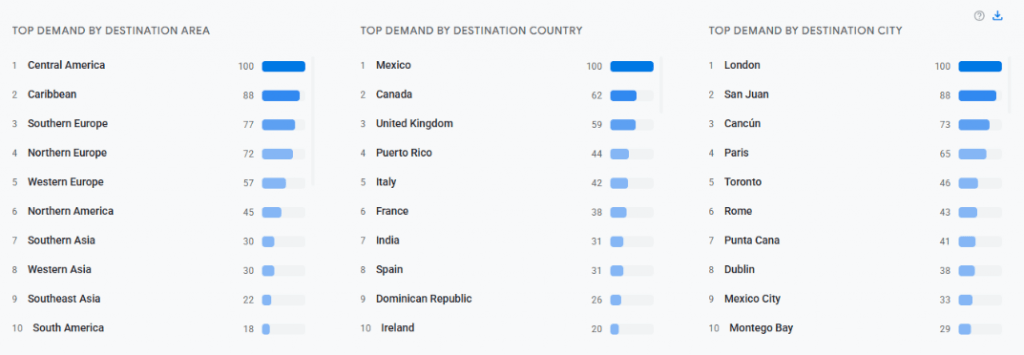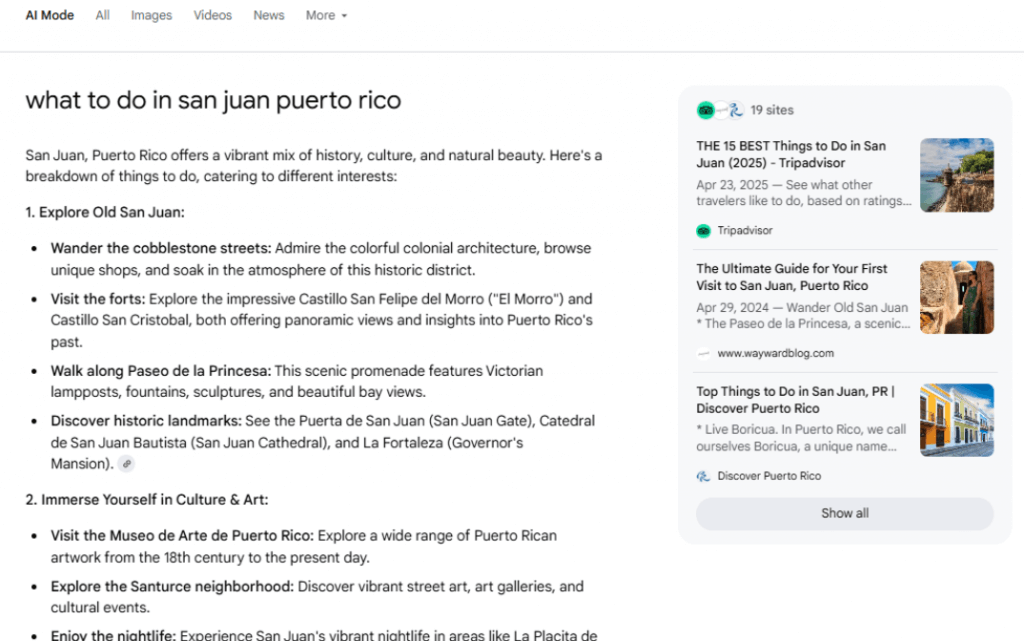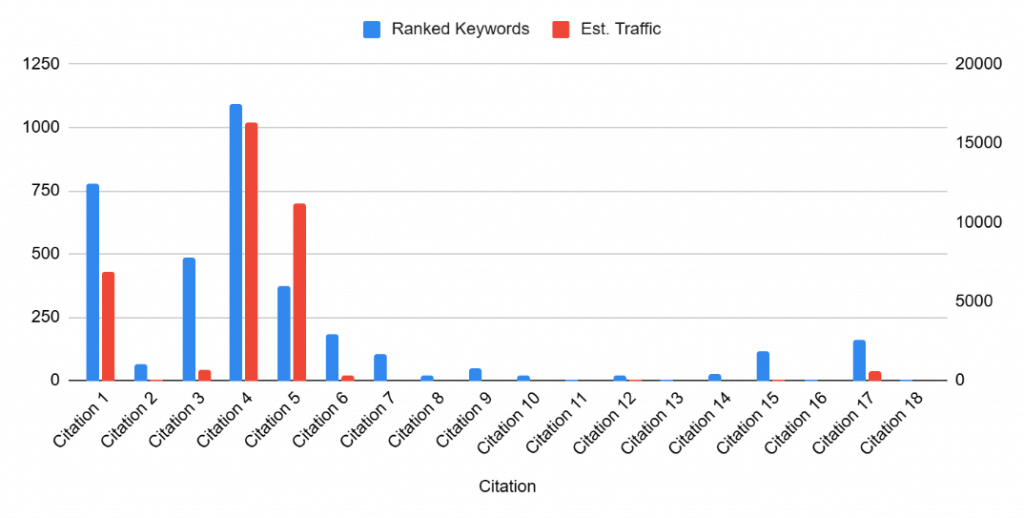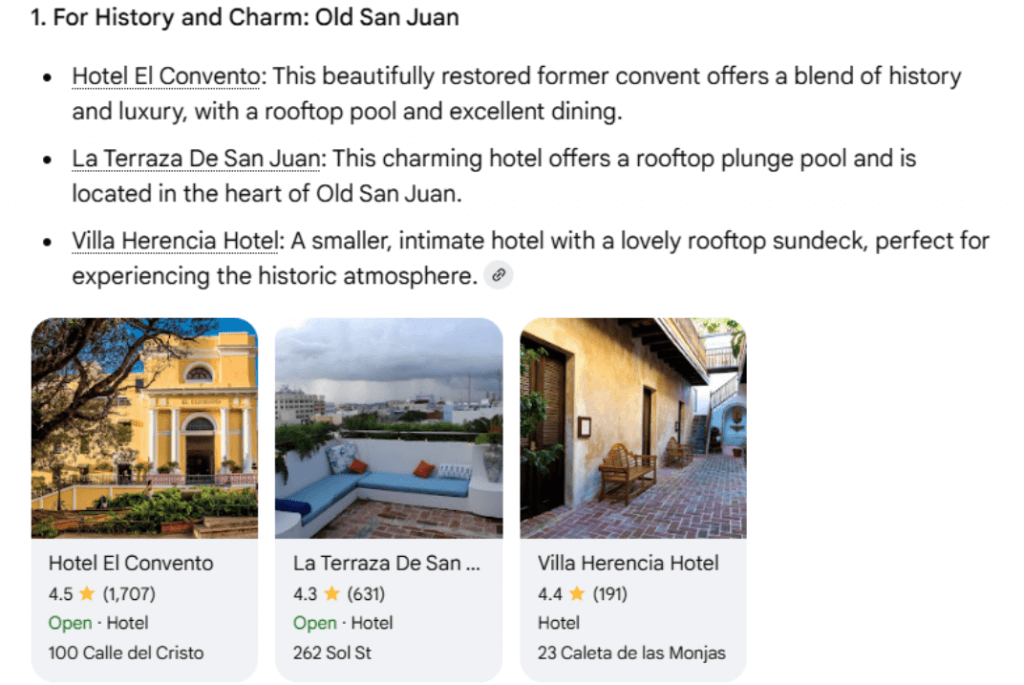How AI Mode may affect Travel companies
The way travellers connect with travel brands is changing fast. The travel sector has faced disruption from Google for a number of years. Special SERP features such as the Flights and Hotels modals, and more recently AI Overviews, have created upheaval for travel SEOs.
When coupled with increased adoption of other LLMs and AI platforms, such as Meta AI and ChatGPT, the travel industry has no choice but to respond just as quickly.
AI Mode adds further disruption to the sector, and this will only continue to change as Google integrates “Personal Context” into AI Mode and other Gemini-powered applications later in the year.
How is AI Mode different for travel queries?
As AI Mode is currently only available in the US, I’m going to show this using (according to Google) one of the highest demand outbound cities currently being searched for in the US: San Juan in Puerto Rico.

Let’s look at three queries with good search volumes for travellers researching San Juan as a destination:
- what to do in san juan puerto rico
- where to stay in san juan puerto rico
- best time to visit puerto rico san juan
[what to do in san juan puerto rico]

The delivery format is very similar to an AI Overview. It was fast,
even though it pulled information from 17 different websites (TripAdvisor and San Juan Insider were cited twice with different URLs).
While it does provide citations for 17 websites, it is blending content from multiple sources to provide a response. The “Enjoy the nightlife” section pulls from four different websites: Discover Puerto Rico, The New York Times, Wayward, and Holidify.
The page referenced from the Wayward website ranks in traditional organic search for four queries related to San Juan and “nightlife”, but all are between positions 24-26. By contrast, the Holidify-cited URL doesn’t contain any information on nightlife, nor does it rank for any queries relating to nightlife. Instead, it is a large aggregator page of “52 best things to do in San Juan”, but the website has a number of dedicated articles covering San Juan nightlife that haven’t been cited.
If we look at the traditional SEO metrics for the cited URLs, we can see patterns supporting the notion that Google’s Hidden Gems is playing a part in the formation of results.

Not all URLs cited are performing well by classical SEO metrics. A third of the cited URLs, according to Ahrefs, aren’t generating any organic traffic at all and the Domain Rating varies from 1.8 to 95.
This breadth of results is down to Query Fan-Out.
Query Fan-Out is a process used by Google’s AI-powered search to better understand and answer user queries. Instead of just searching for the exact query you typed, the AI breaks it into several related sub-queries, runs those in parallel, and then combines the results into a more complete and helpful answer.
This allows it to pull useful information even from pages that don’t rank highly in traditional search results.
[where to stay in san juan puerto rico]
We can see similar patterns with the ‘where to stay’ query.
The response, however, includes a number of different elements to add value for the user, such as specific hotels based on the ‘vibe’ of the hotel and surrounding area.

In addition to mapping out the hotels, a tip calling out specific booking and accommodations websites is included.

The ‘best time to visit’ query had similar responses.
Hotels queries
Much like AI Overviews, Google has a habit of linking back to itself. This is apparent when you search for hotel-related information. For example, I’m looking for [hotels in rouen], and I get a few options broken down by star rating alongside the map feature.

The first result, among others, is hyperlinked, but not to the hotel website. Instead, it pulls through the Google widget for searching and booking the hotel on the site directly – or on aggregator websites.

Google is further creating distance between the travel customer and the brand, while retaining users in their ecosystem. You can see the challenge for SEOs.
How can travel brands prepare for AI Mode?
Travel brands need to recognise that search behaviour is changing. Users are increasingly relying on tools like Google’s AI Overviews, Gemini, and now AI Mode.
Experience-led over keyword-led content
The content strategy must move from keyword targeting to experience targeting. Rather than creating pages around terms like [hotels in Barcelona], brands should publish content to help users imagine what their trip will be like.
This means addressing intent-rich prompts such as [quiet beach towns near Lisbon for couples] or [three-day food itinerary in Osaka]. Capturing the emotional and sensory aspects of travel – what it feels like to arrive in a new place – makes content more compelling for both people and language models.
This is a concept I’ve written about in the past called User Experience Forecasting.
We also need to enrich content with imagery and user validation to show authenticity and underline expertise and ability to deliver the experiences promised.
Travel companies also need to rethink how they present destination guides, hotel write-ups or itineraries. Content needs to feel lived-in and personal, with less focus on generic SEO copy and more on user experience and local insight.
Brands should consider incorporating traveller reviews, staff recommendations, and behind-the-scenes perspectives.
Hidden Gems now front and centre?
Google’s Hidden Gems update was rolled out in November 2023, and for the most part hasn’t impacted travel SERPs. However, the data we’re seeing from AI Mode citations for travel queries indicates that smaller, challenger travel brands may have an opportunity to gain visibility against large travel brands.
By traditional organic metrics, a number of the sites we’re seeing in citations do not have metrics to match the bigger travel sites. They do have hyper-relevance and unique content. That focus on specific topics is helping them to surface in the AI Mode results.
Technical SEO is still important
Technical SEO is key for travel brands to appear in Google’s AI features.
Google needs to be able to find, crawl, and index webpages without issues. Helping provide positive webpage experiences through good page loading speed and aligning with Core Web Vital metrics is essential.
It also allows brands to manage how their content shows in AI results through controls like nosnippet or noindex. It also helps unlock rich features by using structured data that matches what users actually see on the page.
It’s obvious travellers are embracing new ways to search and that’s not going to change. The job for travel brands now is to embrace Google’s new direction towards experience-led, relevant content while continuing to be vigilant with technical SEO practices. It’s the winning combination to keep your brand front-of-mind when people plan their next trip.